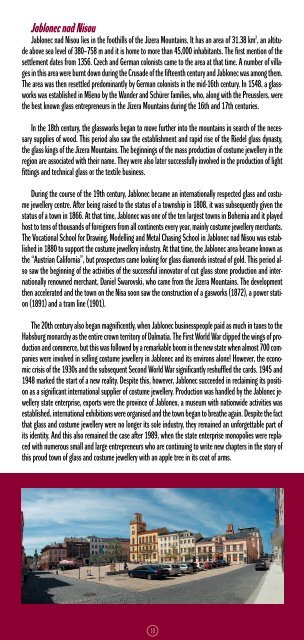Bižuterie a sklo - Informační centrum Jablonec n. N.
Bižuterie a sklo - Informační centrum Jablonec n. N.
Bižuterie a sklo - Informační centrum Jablonec n. N.
You also want an ePaper? Increase the reach of your titles
YUMPU automatically turns print PDFs into web optimized ePapers that Google loves.
<strong>Jablonec</strong> nad Nisou<br />
<strong>Jablonec</strong> nad Nisou lies in the foothills of the Jizera Mountains. It has an area of 31.38 km 2 , an altitude<br />
above sea level of 380–758 m and it is home to more than 45,000 inhabitants. The first mention of the<br />
settlement dates from 1356. Czech and German colonists came to the area at that time. A number of villages<br />
in this area were burnt down during the Crusade of the fifteenth century and <strong>Jablonec</strong> was among them.<br />
The area was then resettled predominantly by German colonists in the mid-16th century. In 1548, a glassworks<br />
was established in M‰eno by the Wander and Schürer families, who, along with the Preusslers, were<br />
the best known glass entrepreneurs in the Jizera Mountains during the 16th and 17th centuries.<br />
In the 18th century, the glassworks began to move further into the mountains in search of the necessary<br />
supplies of wood. This period also saw the establishment and rapid rise of the Riedel glass dynasty,<br />
the glass kings of the Jizera Mountains. The beginnings of the mass production of costume jewellery in the<br />
region are associated with their name. They were also later successfully involved in the production of light<br />
fittings and technical glass or the textile business.<br />
During the course of the 19th century, <strong>Jablonec</strong> became an internationally respected glass and costume<br />
jewellery centre. After being raised to the status of a township in 1808, it was subsequently given the<br />
status of a town in 1866. At that time, <strong>Jablonec</strong> was one of the ten largest towns in Bohemia and it played<br />
host to tens of thousands of foreigners from all continents every year, mainly costume jewellery merchants.<br />
The Vocational School for Drawing, Modelling and Metal Chasing School in <strong>Jablonec</strong> nad Nisou was established<br />
in 1880 to support the costume jewellery industry. At that time, the <strong>Jablonec</strong> area became known as<br />
the “Austrian California”, but prospectors came looking for glass diamonds instead of gold. This period also<br />
saw the beginning of the activities of the successful innovator of cut glass stone production and internationally<br />
renowned merchant, Daniel Swarovski, who came from the Jizera Mountains. The development<br />
then accelerated and the town on the Nisa soon saw the construction of a gasworks (1872), a power station<br />
(1891) and a tram line (1901).<br />
The 20th century also began magnificently, when <strong>Jablonec</strong> businesspeople paid as much in taxes to the<br />
Habsburg monarchy as the entire crown territory of Dalmatia. The First World War clipped the wings of production<br />
and commerce, but this was followed by a remarkable boom in the new state when almost 700 companies<br />
were involved in selling costume jewellery in <strong>Jablonec</strong> and its environs alone! However, the economic<br />
crisis of the 1930s and the subsequent Second World War significantly reshuffled the cards. 1945 and<br />
1948 marked the start of a new reality. Despite this, however, <strong>Jablonec</strong> succeeded in reclaiming its position<br />
as a significant international supplier of costume jewellery. Production was handled by the <strong>Jablonec</strong> jewellery<br />
state enterprise, exports were the province of Jablonex, a museum with nationwide activities was<br />
established, international exhibitions were organised and the town began to breathe again. Despite the fact<br />
that glass and costume jewellery were no longer its sole industry, they remained an unforgettable part of<br />
its identity. And this also remained the case after 1989, when the state enterprise monopolies were replaced<br />
with numerous small and large entrepreneurs who are continuing to write new chapters in the story of<br />
this proud town of glass and costume jewellery with an apple tree in its coat of arms.<br />
10


